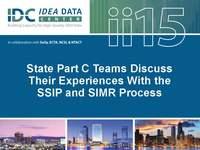Site Search
Results 1 - 5 of 5
Format: Presentations
Where Do They Go? Capturing Accurate Part C Exiting DataThe presentation explored challenges that states and local regions face in accurately capturing Part C Exiting reasons. The IDC Part C Exiting workgroup has been developing a tool to assist with these challenges. The presentation was interactive, drawing on the experiences of new and seasoned data managers.
Format: Presentations
State Part C Teams Discuss Their Experiences With the SSIP and SIMR ProcessThe presentation focuses on experiences of State Part C teams in analyzing data, selecting their SIMR, and completing their SSIP. Guiding questions help states connect Phase I and Phase II planning.
Format: Guides, Papers, and Reports
Examining Part C Exiting Data VariationUsing national averages for each of the exiting categories, this white paper helps state personnel examine differences in their Part C Exiting data. The paper explores Part C Exiting data category definitions, as well as general and specific trends in Part C Exiting data. It also includes suggestions for possible strategies to improve data quality, including clarifying policies and definitions, documenting procedures for implementation of policies, and developing training materials related to reporting exiting data.
Format: Presentations
Issues in Adoption & Implementation of EBPs in Early Childhood ProgramsThe presentation reviews key issues related to EBPs including definitions, selection issues, fidelity and usability concerns, and challenges of early and mid-stage implementation. The presentation offers Information on issues and challenges encountered in selection and implementation of EBPs.
Format: Presentations
Leveraging Internal Resources and Working Across Systems to Achieve SIMRsThe presentation provides an overview of how states have improved results for infants, toddlers, and students through coordinated processes and planning at the state and local levels. Strategies include leveraging resources, considering related initiatives to support the SIMR, and communication protocols.






